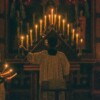For my Bible reading this year, I am using the NIV Cultural Backgrounds Study Bible (Zondervan, 2016), edited by John H. Walton, Professor of Old Testament at Wheaton College. I have been humbled by how little I knew about the cultural contexts of Old Testament writers, stunned especially by their religious appropriations. I shouldn’t be. After all, my scholarly discipline is cultural studies, which explains why I have written books about postmodernism, semiotic theory, and film. But I grew up assuming that the words of the Bible just floated down from heaven ready made—much as I imagined a baby floating down from heaven when my parents answered the question “Where did my brother come from?” with “God sent him to us.” Having compartmentalized my Christianity during grad school, it was only after I started teaching at a Christian liberal arts institution that I recognized my Docetic approach to Scripture. Just as Docetists in the early centuries of Christianity assumed that Jesus, the divine Word of God, wasn’t fully human, I assumed that the Bible, the divine Word of God, wasn’t fully human. Docetism, of course, was dismissed as heresy during the First Ecumenical Council at Nicaea in 325.
My own lingering Docetism became apparent as I read Walton’s edited commentary on Psalm 23. I was surprised to discover that “The Lord is my shepherd” (Ps 23) echoes metaphors that Mesopotamians and Egyptians used for their sun-gods, that Babylonians applied to their god Marduk, and that one Sumerian employed for a god who leads him to good pastures. The Psalmist, of course, was doing what pastors and priests do today: preaching salvation using language and imagery understandable to the culture in which he was embedded. And it is for this reason that I consider the Christian liberal arts so important: They introduce students to historical contexts and linguistic paradigms that affect the way we understand and apply the truth of God’s Word, which, as the Psalmist puts it, “is a lamp for my feet, a light on my path” (Ps 119:105). Significantly, as the Zondervan notes for this famous verse explain, “In a culture for which the night held many terrors (91:5), the light of a lamp meant safety (18:28). An Assyrian prophecy refers to the goddess Ishtar shining light from a lamp . . . upon King Esarhaddon in order to see and protect him (cf. Job 29:2-3).”
Changing perceptions of God’s unchanging light might be illustrated with the North Star. It has projected its light for millions of years, guiding thousands of ships to their destinations. However, depending upon where each ship is floating, a crew will see the star in relationship to their location differently. At certain times the star appears off the starboard bow, but at other times it is directly behind them. And under certain conditions—fog, rain, interfering land masses—the crew does not see the star at all; nevertheless, the light continues to shine beyond the obstructions. Even when the star is readily apparent, the kind of boat and the sea in which it navigates will affect how the crew will apply the light of “true north” to their behavior: some furl their sails, others feed fires with coal, and a few even make their calculations on computers. Finally, the way different ships search for “true north” differs from era to era. In the earliest days of navigation, humans had to rely on the naked eye, whereas today’s navigators have highly complex technological devices to ascertain true north. Even though technology has changed the mediums of perception over the centuries, it’s still the same star, no matter how sophisticated human devices become.1
Similarly, no matter how sophisticated our devices of theological language become, the Christ directing us today is the very same Christ that directed the course of second century Christians who—in the catacombs—inscribed not a single cross on the walls, but instead drew over forty pictures of Noah’s Ark. After all—in their historical context—the cross was a Roman torture device: a symbol of death. Meanwhile the Ark symbolized salvation. As theologian Kevin Vanhoozer, puts it, “While God’s truth is eternal, our theologies inevitably show the signs of the times in which they were conceived.”2 Christian liberal arts is about assessing signs of the times, not only our own, but those of people who have preceded us, both Jewish and Christian, both male and female, both slave and free.























